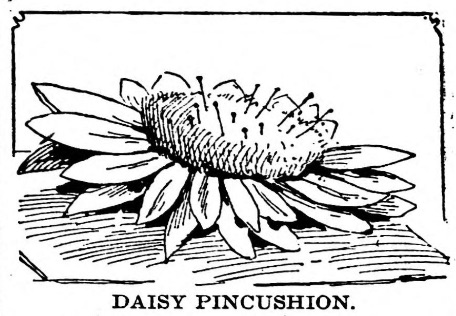
I think that a daisy pincushion is a brilliant idea, but I would make it differently than the instructions from 1897. For one, I would probably buy a few fabric daisies and use the petals instead of sewing my own. I would also make the center pincushion a lot small that the size suggested.
Daisy Pincushion
This marguerite pincushion is suggested, of course, by the simple daisy. To develop it satisfactorily, get about a yard of good quality ivory silk, a half yard of leaf green Roman satin, a quarter yard of bright yellow silk, some stiff cardboard, and a small quantity of wadding.

Everybody knows the arrangement and shape of marguerite petals. Cut out about 16 petals from some crossbar white muslin, the petals to be from three to four inches long and three-fourths of an inch wide. As a center, cut a round piece of cardboard with a 12-inch circumference and lay quite a two-inch depth of the wadding upon it, being careful, however, to place the padding thicker in the center, so that the rounded heart of the natural flower may be reproduced. To keep the wadding in place cover it with a piece of thin white muslin, which can be gummed to the underneath part, and then sew on the petals, arranging them so that the shorter ones may come on top of the longer.
To decorate the center now, proceed to unravel the yellow silk, and when all the strange are separated, cut them into two-inch lengths, and, taking eight or ten strands at a time, catch them down with a stitch in the middle to the padded cardboard until every part of the foundation is completely covered. This will be found to give the soft fluffy effect of the flower center and all the uneven ends must be cut off so that there remains an even surface of about an inch in depth in which the pins can be stuck. The frayed silk must be placed quite to the edge so that the joining of the petals to the center may be completely hidden.
For the mount of the pincushion, cut a square of cardboard a little smaller that the whole flower, and cover it with the green satin, attaching it either by stitches or glue to the under part. Secure a roll of satin covered cardboard upon this, to which the flower must be fastened; it must be deeper at the back than in the front, so that the daisy may incline forward somewhat.
Source: Willmar tribune. (Willmar, Minn.), 26 Oct. 1897.

